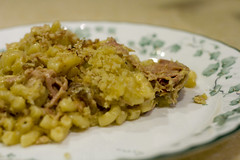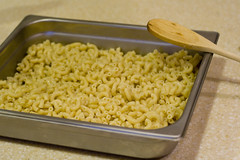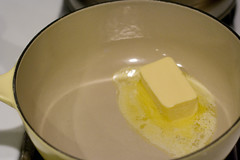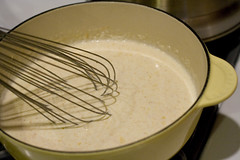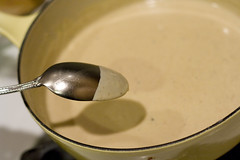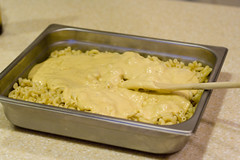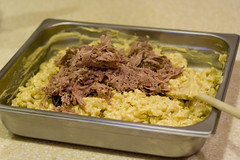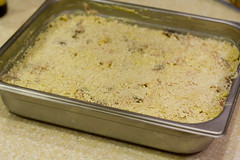Macaroni and cheese is an essential element of comfort cooking. For many people, like myself, Kraft Mac and Cheese was a building block of our diets, not only growing up, but into early adult hood when budgets were tight and Kraft was cheap. Kraft Mac and Cheese is velvety smooth, cheesy, delicious, filling, and these days, mostly crap.
Even in the fancier organic mac and cheese boxes there is very little, if any, real cheese included. Even when there is, the ingredients have been processed to such a high degree that they barely resemble food at all. As much as I like the Kraft Mac and Cheese, still, I'm convinced that the packaging actually has more nutritional value than the contents.
Even if it did have real cheese, it doesn't come with pulled pork, and mine does. Making mac and cheese from scratch is easy, takes very little time, and delivers a far superior product. When it's done you can be relatively certain that it contains real food and no monosodium poisonate.
- 16 oz of pasta cooked al dente
- 4 oz to 16 oz pulled pork
- 4 tablespoons butter
- 1/4 cup flour
- 2 cups heavy cream
- 4 oz to ∞ of cheese
- Panko bread crumbs
- salt and pepper to taste
Preheat your oven to 350f. Drop your pasta in boiling water and cook until al dente, about 10 minutes. I like to use elbow macaroni or shells, but really any small pasta with lots of nooks will work well. Don't be afraid to experiment. When the pasta is done, drain it and toss it into a proper sized baking dish. I'm using a half steam pan.
In a sauce pan, melt the butter over medium heat, but don't let it brown You can really use any pan or skillet, but because we're making a sauce here, I prefer a proper sauce pan, one with gently sloping sides that allows the whisk to get in, and made of a heavy slow and even conductor. I'm using a La Creuset cast iron sauce pan here.
When the butter is melted, dump in the flour and commence to whisking. Whisk away! Continue to whisk constantly for at least 2 minutes. Hooray! You just made a roux. Keep an eye on the temperature and the roux, if it starts to darken, turn down the heat a little. Keep whisking, don't stop. Cooking the roux for 2 minutes cooks out the flour taste. This is important if you don't want your mac and cheese to taste like glue. If you like the way glue tastes, I guess you don't have to bother.
Pour in the cream, and keep whisking. As you whisk, the sauce will start to thicken. Depending on how warm the cream was relative to the roux, and how fast you poured it in, the sauce will either set up quickly or a little more slowly. If you attempted to use fat free milk, it will take longer and be terrible. Don't do that. Some people will say you should add in the cream slowly, or heat it up first. Since we're pumping this full of cheese and baking it later, this isn't really that important.
Hey, you just made a Bechamel sauce! You're a fancy French chef now. Go tell all your friends, but wait until we're done here first. You don't want to burn the sauce, and ruin all your new French Chef cred. The Bechamel, or sauce blanche, is one of the French mother sauces and is the basis for a number of super delicious sauces such as Mornay and Soubise sauce. You may have also noticed that it's basically just gravy. I just saved you three weeks of culinary school.
When the sauce is done to your desired consistency, coating the back of a spoon is a common test, lower the heat and pop in the cheese. Add the cheese in a bit at a time, other wise it will be hard to stir in smoothly and it may break or clump. Since you stuck a spoon in it, you might as well taste it. Resist the urge to eat it all. Add salt or pepper as you see fit.
A word about cheese. Use a cheese that is a good melter. I like smoked gouda. Hard cheeses can be used, but will often yield a grainy texture after baking. I like to add a little manchego because I like the flavor. Cheddar is the typical American addition, and works, but it has a tendency to break more often in my opinion and why use cheddar when you can use something as tasty as smoked gouda? It's really a matter of taste though, as is the amount. The more cheese you put in, the cheesier your mac and cheese will be. 4 ounces is about the minimum and 8 ounces is a good place to stop before going crazy.
When the cheese is all melted in to the sauce, pour it over the pasta and mix it up good. Toss in the pulled pork and mix to combine. Wait, you don't have pulled pork? I'm shocked. Shocked I tell you. Well, we'll cover that some other time. For now, reasonable pulled pork can be had at the grocery. I'm so embarrassed right now.
Pat the mixture down evenly and, oh wait. Listen, the baking part. It's not really necessary. You can eat it just like that. Go ahead, I won't stop you. Baking does make it kinda tastier though. Still with me? Okay, pat the mixture down evenly and sprinkle the Panko bread crumbs in a layer over the top. I like to spritz it with a little olive oil too, just to make the crumbs crisper. Panko isn't necessary if you don't have any. Any bread crumbs will do, they just aren't as tasty. Hell, you can replace the bread crumbs altogether with crumbled bacon.
Pop the pan in the oven for 30 minutes and sit on your hands. You have to sit on your hands because your kitchen will start to smell like miracles and fairytales and you'll want to pull the mac and cheese out before it's done.
Serve immediately. Serves up to eight, or as few as one.
